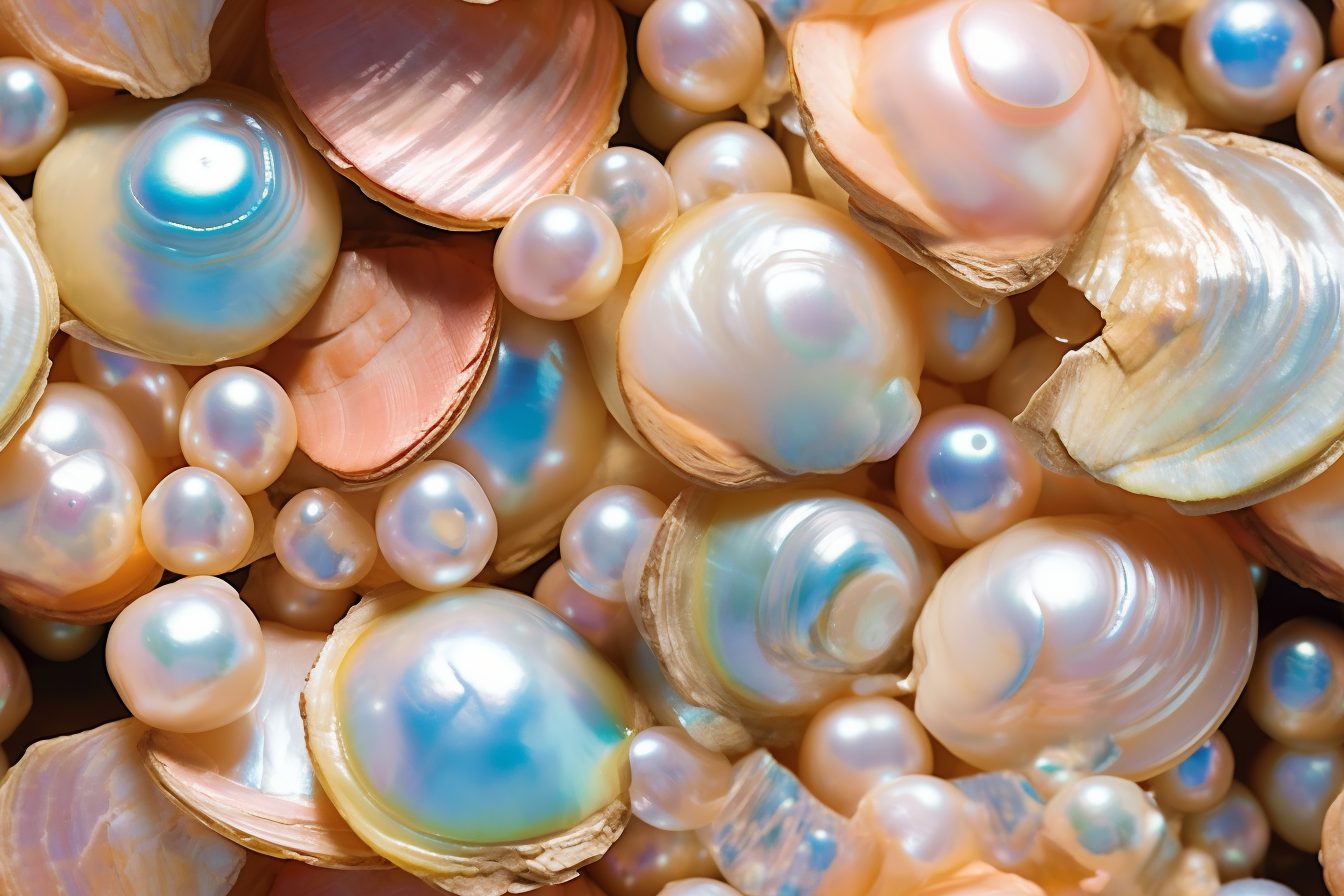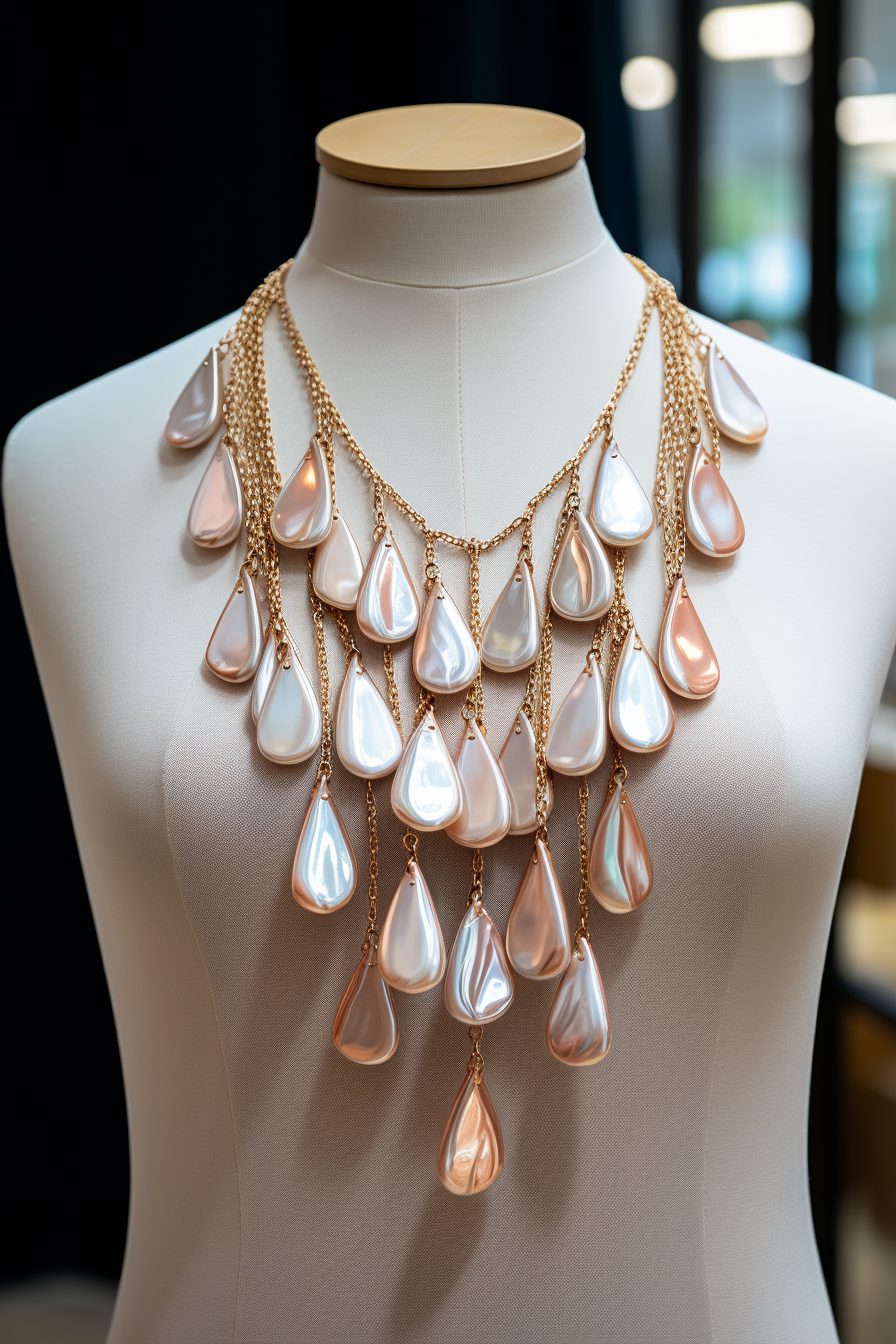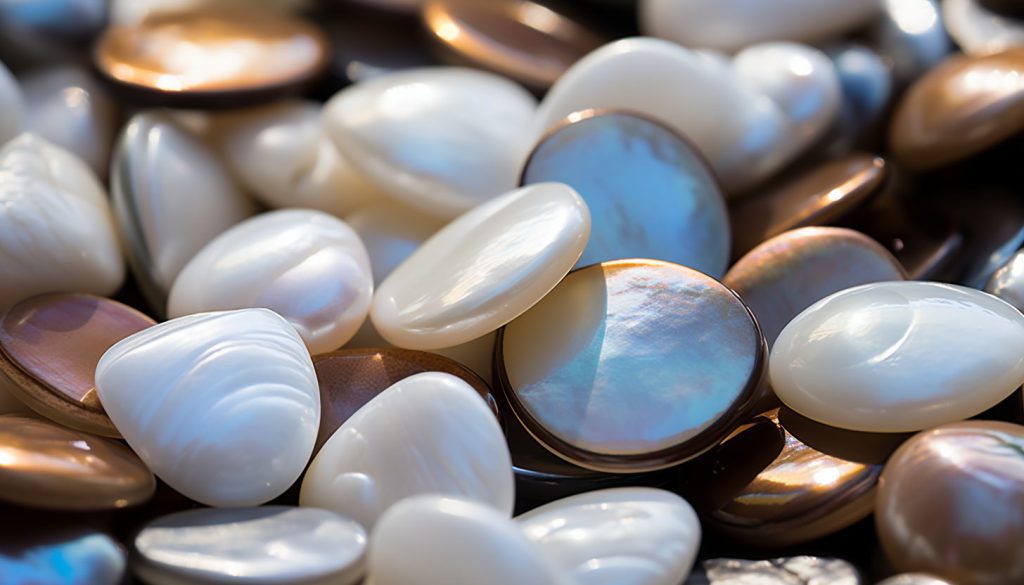The Magical Beauty of Mother of Pearl
Mother of Pearl is surely one of the most magical beauties because of its iridescent luster and the various hues that seem to have been carefully printed on it, captivating people all over the world from diverse cultures. Its common name, ‘Nacre’, is a biomineral marvel that has drawn people’s admiration and spurred competition through different ages. Not only is it the innermost layer of some kinds of shellfish, but it is also what pearls are made of. Widely used in jewelry, decoration, and fashion, its amazing magic spans time, serving as a human-made garment intertwined with the history of humanity, art, and adornment.
Mother of Pearl, also known as nacre, is an iridescent composite material secreted by some mollusks as an inner shell layer. This iridescent beauty, often favored in jewelry and decor, still rides the peak of its fame as a fashion accessory symbolizing the timeless beauty of nature. The different colored and shaped variants of Mother of Pearl discussed in this article include shades of pink and white, created by various mollusks. The source is based on environmentally friendly production and ethical harvesting.
Mother of Pearl is a complex material that can have natural or superfluous properties, often biogenic, and varies from synthesized to highly ordered natural polymers. The reflective phenomenon is caused by different viewpoints of light rays entering and exiting the material. The creation of mirrored laces to replicate the natural beauty of Mother of Pearl is one of the decorative arts that blends traditional craft with modern innovation.
Forming Mother of Pearl is a marvel of nature. Mollusks such as oysters and mussels excrete nacre, the substance that forms Mother of Pearl, as a defense mechanism when their soft body parts are injured. This substance is then deposited layer by layer, working as an extra shield for both the mollusk and its shell. This entire process culminates in the splendid lining we know as Mother of Pearl.

The way these thinner nacreous layers reflect light gives Mother of Pearl its distinctive iridescence. Just like sets of reflecting glasses, each layer of nacre is only several micrometers thick, and when a light beam hits it, the light bends or refracts differently in each layer, creating an interference effect. This refraction accounts for the characteristic glittering, multicolored appearance of Mother of Pearl, known as the ‘orient’. This orient varies depending on the inner design of the shell, making each piece of Mother of Pearl a unique natural wonder.
Mother of Pearl Symbolism and Significance
Mother of Pearl has held deep meaning throughout history and across various cultures. Often representing luck, wealth, and opulence, its connection to the sea makes it a symbol of protection, especially in maritime contexts where it stands for safe travel. Beyond its aesthetic appeal, Mother of Pearl is believed to hold healing powers. Gemstones, including Mother of Pearl, have been used for millennia as powerful tools to aid in the well-being and spiritual lives of people. Its significance is evident across cultures, from the Heavenly Tablets used to heal the ill to its representation of life force and fertility in Pacific Island cultures.
In Asian cultures, Mother of Pearl is often seen as a charm for good fortune and prosperity. It plays a significant role in Feng Shui, symbolizing material wealth and abundance. In Native American and Indian subcontinent traditions, it is considered a medicinal alloy with healing and protective properties. These cultural references highlight the vital role Mother of Pearl plays in the world, bridging different traditions with its timeless beauty and symbolism.
Folklore and Cultural References to Mother of Pearl
Apart from its symbolism, Mother of Pearl has been featured in numerous cultural narratives and folklore. In Greek mythology, the shiny Mother of Pearl was believed to have created Aphrodite, the goddess of love and beauty, from the sea foam.
The iridescence of Mother of Pearl is revered in Maori culture, where it is considered a symbol of wisdom and knowledge, often represented in traditional carvings.
In ancient Egypt, Mother of Pearl was associated with Isis, the goddess of life and magic, and was believed to possess healing properties. This association with protection and health further cemented its importance in Egyptian culture.
In Chinese culture, Mother of Pearl is a significant symbol, often featured in sculptures and artifacts themed with dragons, representing power, prosperity, and luck. These references not only justify the place of Mother of Pearl in culture but also unveil its global significance and interconnections.
Varieties and Colors of Mother of Pearl
Mother of Pearl comes in various colors and types, but all share a unique attraction. The color scale of Mother of Pearl ranges from white, cream, and silver to more vibrant colors like pink, blue, green, and even black. The mollusks that produce it greatly influence these colors and tones.
For example, White Mother of Pearl, one of the many types, usually comes from warm tropical seas inhabited by pearl oysters. Black Mother of Pearl, which exhibits interesting shades of grey, blues, greens, and purples, is particularly produced from the black-lip oyster found in the Pacific Ocean. The Mother of Pearl shell extracted from the abalone species can be completely white or exhibit blues, greens, and purples.
| Mother of Pearl Type | Color |
|---|---|
| Oestridse, the so-called white mother-of-pearl, is the best of its kind located in the Tropical Sea | White, Cream, and Silver |
| Black Pearls from the Pacific Black Mother of Pearl | Grey, Blue, Green, Purple |
| Cold Water Abalone Sea Snails (New Zealand, South Africa, California) Abalone Mother of Pearls | Blue, Green, Purple |
What Mother of Pearl is Used For in Jewelry and Decor

Mother of Pearl is among the most sought-after jewelry items not only because of its sheen but also its malleability, making it a versatile material for various applications. Its great luminosity and range of colors have led to a huge variety of necklaces, bracelets, earrings, brooches, and rings.
Beyond jewelry, Mother of Pearl is famous for its use in a wide range of decorative items. It can be carved and shaped, and has been used in inlay work for the decoration of furniture and musical instruments like guitars and violins. Additionally, buttons made of Mother of Pearl have long been admired for their resistance and brightness.
In interior architecture and design, Mother of Pearl is commonly used as mosaic and wall tiles in luxury hotels, cafes, and public places, adding a touch of elegance and brightness. It is also often found in religious and ceremonial objects such as Christian icons, altarpieces, Buddhist sculptures, and Islamic book covers, indicative of its ageless appeal across various cultures and civilizations.
Mother of Pearl in Fashion: From Buttons to Exquisite Accessories
Throughout history, Mother of Pearl has been a prime element in fashion, particularly in clothing. Although the materials used in fashion have varied, the most popular application has been in buttons for shirts and jackets. Despite their small size, these buttons can enhance the sophistication of even the most ordinary top or blouse, providing a glossy effect that plastic buttons cannot achieve.
In addition to buttons, Mother of Pearl is also common in accessories such as earrings, necklaces, bracelets, and rings. The iridescent beauty of Mother of Pearl allows for versatile style combinations and outfit matches. The elegance of watches featuring Mother of Pearl on their faces embodies the very essence of iridescence.
Sustainable Harvesting and Ethical Considerations of Mother of Pearl
In building a house that harmonizes with natural elements, Mother of Pearl can be used in traditional ways by local communities.
Most people prefer natural and unprocessed products, and Mother of Pearl fits the bill. However, the way this material is harvested and produced raises ethical concerns. Overfishing causes certain species of mollusks to die off, disrupting the marine ecosystem. Therefore, when purchasing Mother of Pearl, it is important to ensure that it comes from a sustainable source.
Many jewelry and fashion brands today strive for green product sourcing and environmental empathy, proudly declaring that their items are eco-friendly. Some producers even support ocean preservation by allocating a portion of their profits to this cause.
By choosing to buy products that respect the environment and do not harm biodiversity, we can help preserve the marine ecosystems that allow Mother of Pearl to thrive. Ethical and sustainable fishing practices will ensure that this natural spectacle continues to be admired by future generations without causing harm to our world.
Mother of Pearl vs Pearl: Differences and Similarities
A comparison between Mother of Pearl and pearls reveals that while both come from oysters and mollusks, they have key differences. One of the main differences lies in their formation. A pearl forms when a foreign object, such as a grain of sand, is introduced into the mollusk. The mollusk then coats this object with layers of nacre, eventually forming a pearl. In contrast, Mother of Pearl refers to the iridescent lining of the mollusk shell, where the same nacre process occurs.
Pearls are typically round and uniform in shape, while Mother of Pearl can be cut from the shell into various shapes and sizes. Despite these differences, both possess iridescence, with Mother of Pearl often displaying a wider range of colors, from white and cream to blue, green, and even purple.
| Mother of Pearl | Pearl | |
|---|---|---|
| Formation | Lining on the inner shell of mollusks | Foreign matter trapped by the mollusk and slowly coated with nacre |
| Shape and Size | Available in different shapes and sizes | Rounded and usually uniform |
| Color | Varied colors from whites and creams to blues, greens, and purples | Popular colors are white, cream, and black |
| Iridescence | Strong iridescence, being a layer of the shell | Minimal iridescence in a single rounded form |
| Price | Usually less valuable compared to pearls | Costlier, especially in larger high-quality pieces |
Caring for Your Mother of Pearl Pieces: Essential Tips
Mother of Pearl requires proper care and maintenance to preserve its beauty. Despite its high hardness, it can still be scratched or damaged by chemicals. Here are some tips to keep it looking its best:
- Avoid Chemicals: Keep your Mother of Pearl away from harsh chemicals such as chlorine, perfume, and cleaning solutions, which can strip away its nacre and luster.
- Gentle Cleaning: Use a soft cloth slightly dampened with water for cleaning. For heavier dirt, a mild soap solution may be used. Avoid scrubbing or using abrasive cleaners.
- Proper Storage: Store your Mother of Pearl pieces in pouches or padded jewelry boxes to prevent scratching. Do not place items on top of each other.
- Regular Inspection: Frequently check your Mother of Pearl jewelry for signs of wear or damage. If you notice any damage, seek professional repair.
Following these care tips will help ensure that your Mother of Pearl jewelry and home decor pieces retain their unique iridescence for years to come.
Spotting Genuine Mother of Pearl: A Buyer’s Guide
When shopping for Mother of Pearl, it’s important to distinguish between genuine and fake products. Genuine Mother of Pearl has a deep iridescence and luster not found in imitations. The refraction of light within the layers of nacre creates a rainbow-like effect, which is a key indicator of authenticity. Additionally, real Mother of Pearl feels cool to the touch and has a smooth, lustrous quality.
However, the market is flooded with fake or low-quality Mother of Pearl products, so it’s essential to buy from trusted suppliers. Look for signs of quality assurance such as consistency in iridescence and good craftsmanship to avoid purchasing defective items.
Modern Applications and Innovations of Mother of Pearl
Even after hundreds of years, Mother of Pearl continues to captivate the world. Scientists and designers are constantly finding new ways to use it in innovative applications. Its unique characteristics make it ideal for luxury watches, musical instruments, and even architecture and interior design. Recent studies have explored its potential as a building material due to its strength and biocompatibility. Additionally, Mother of Pearl plays a role in the push for sustainable materials, as the process of handling it becomes more gentle in response to growing environmental awareness.
Did you know that nacre, the substance that forms Mother of Pearl, has inspired scientists to create tougher ceramics and advanced body armor? This fascinating material continues to influence modern science and design.
Conclusion: The Everlasting Allure of Mother of Pearl
Mother of Pearl is a substance that has fascinated humanity for ages, from ancient times to the present. Its preciousness, bright symbolism, strength, and ever-changing nature make it a cherished component of jewelry and decoration. From its intricate formation inside seashells to its enduring popularity in fashion and decor, Mother of Pearl is truly unique in both nature and human craftsmanship. As we continue to learn more and discover new uses for this remarkable material, its aesthetic appeal will only grow. Whether you are a collector of jewelry, a lover of natural beauty, or someone who appreciates the interplay of light and color, Mother of Pearl offers something for everyone.
Most Popular Questions
Why is mother of pearl expensive?
It is expensive to produce Mother of Pearl because the production process is not only slow but also complicated. Mollusks need to grow for several years under exact conditions, usually oysters or abalones. Its rarity, time of formation, and labor-intensive harvest process all contribute to its high price.
What is real mother of pearl?
Real Mother of Pearl, or nacre, is a biomineral made by the innermost shell layer of certain mollusks. It is characterized by its iridescence and smooth luster, which are created when light reflects off its layers.
What is the difference between mother of pearl and pearl?
Pearls and Mother of Pearl are both products of mollusks. The main difference lies in their formation. A pearl forms when a foreign particle penetrates the host organism and becomes coated in layers of nacre, eventually forming the pearl. In contrast, Mother of Pearl refers to the nacreous lining inside the mollusk’s shell.
Is mother of pearl a gem?
No, Mother of Pearl is not a gemstone, but it is often used similarly in jewelry and decoration due to its brilliant and shiny appearance. It is classified as an organic mineral.
Is it good to wear mother of pearl?
Absolutely. Mother of Pearl is believed to be a calming and stress-relieving material. Its benefits may vary depending on cultural or personal factors.
What is the most expensive pearl in the world?
As of my last update in September 2021, the most expensive pearl in the world is the famous Pearl of Allah, also known as the Pearl of Lao Tzu, valued at around $100 million.
Can mother of pearl get wet?
Mother of Pearl is sensitive to water. It is advisable to avoid getting it wet, as prolonged exposure to water can lead to fading or damage over time.
Can you wear mother of pearl every day?
Yes, you can wear Mother of Pearl every day, but it should be handled with care. It is a soft material that can be easily scratched or cracked, so avoid exposure to harsh chemicals like make-up and perfume.

